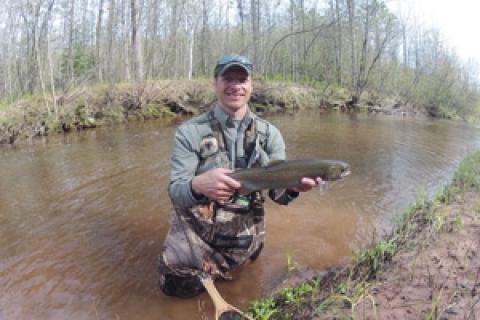
 If you are looking for a way to stand out from the crowds this spring, then understanding how the two-fly rig can work for you is a must. The general principle is if one fly is good then two must be better. Come spring, Rainbows and Cutthroats feed incisively on the emerging and hatching aquatic insects. Keeping this idea in mind and giving these fish what they want will help you key in on big rainbows and cuts.
If you are looking for a way to stand out from the crowds this spring, then understanding how the two-fly rig can work for you is a must. The general principle is if one fly is good then two must be better. Come spring, Rainbows and Cutthroats feed incisively on the emerging and hatching aquatic insects. Keeping this idea in mind and giving these fish what they want will help you key in on big rainbows and cuts.
Depending on where you live, different aquatic insects will be present at different times in the river. In most cases Stonefly, Mayfly and Caddis nymphs can all be found in the spring. Targeting these three main groups along with mixing in a few egg patterns should give the best chance at hooking up.
Dropper/Dropper Rig
The two-fly rig (dropper/dropper rig) can be one of the most productive methods for catching trout with flies. This rig is made up of two different nymph patterns connected together. The important point here is anglers can present two different fly patterns at different depths. This technique allows you to search the water column very effectively and find what fish are feeding on. If you catch a fish on the bottom fly, fish your dropper rigs slower so both flies get down to the right depth. If the strike comes on the upper of the two flies, then switching to flies without weight to keep your patterns higher in the water column is crucial.
The set up for the dropper/dropper rig is quite simple. The first fly in the rig is where you should have the majority of the weight. Using bead-head patterns with natural materials and colors is common for this first fly in sizes 8-12. For the second fly, patterns in the 12-18 range are typical and mostly incorporate some sort of hot color to grab the fish's attention. The length of the leader between the two flies ranges from 12-24 inches depending on the depth of the water. Tie the leader onto the hook bend of the first fly with a clinch knot.
As far as presenting this two fly rig goes, false casting needs to be removed from your train of thought. False casting will only cause tangles and frustration. If you need to get line out, stripping and roll casting is what you should do. Fish the two fly rig as you would a single nymph pattern with a drag free drift. Anytime the indicator pauses, dips or dives; set the hook and check if a fish is pinned.
Dry/Dropper Rig
The second of the two fly rigs that can be used to take rainbow and cutthroat trout is the dry and dropper rig. This rig differs from the dropper/dropper rig in that the first fly is a dry fly instead of a nymph and this dry replaces your strike indicator. This rig is great on warm spring days when stoneflies are hatching off the water and you are seeing fish rise. This technique allows you to target these actively feeding fish while at the same time still presenting flies to fish feeding on the bottom.
To set up this rig for trout, start with a dry fly that is going to be big enough to support your nymph. Ideally you want a pattern that incorporates some type of foam into its construction and a bright colored tag so that you can visually pick it up even in the roughest of water conditions. The nymph needs to be weighted so that it can get down to the bottom, but not so much that it drowns your dry fly. Connect the nymph to the dry with a 24- to 36-inch leader. If you plan on fishing deeper water then you might need to extend this leader even more, but this makes the rig harder to handle and cast. Since the dry fly is light you can cast and present this rig like you would a single nymph and indicator setup. Mend the line as the flies drift to keep a drag free float for the dry. Again, any time you see movement to the dry fly, lift the rod and feel if there is any weight on the dropper pattern.
With a dropper/dropper or dry/dropper set up, you double your chances for Rainbow and Cutthroat trout. With a little practice, this technique can reap big rewards and exciting days of fishing.
- 3398 views

